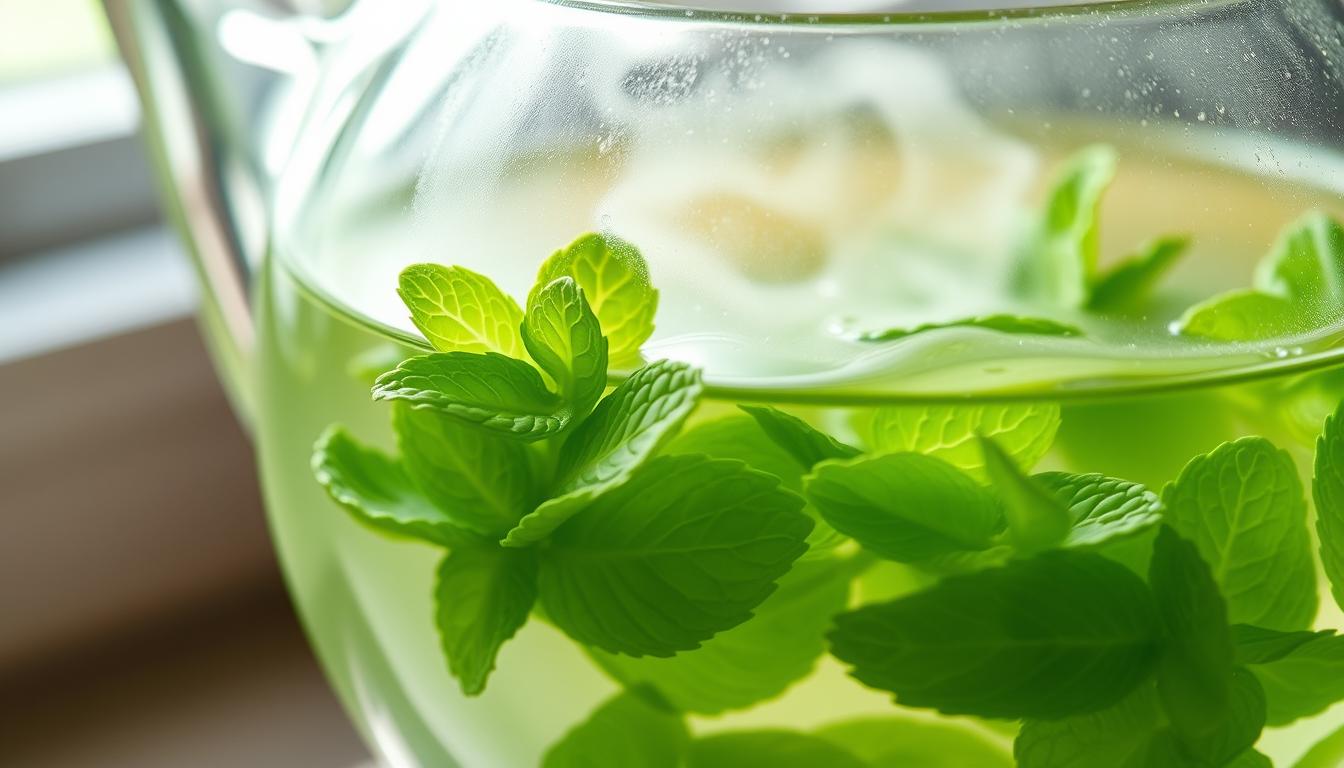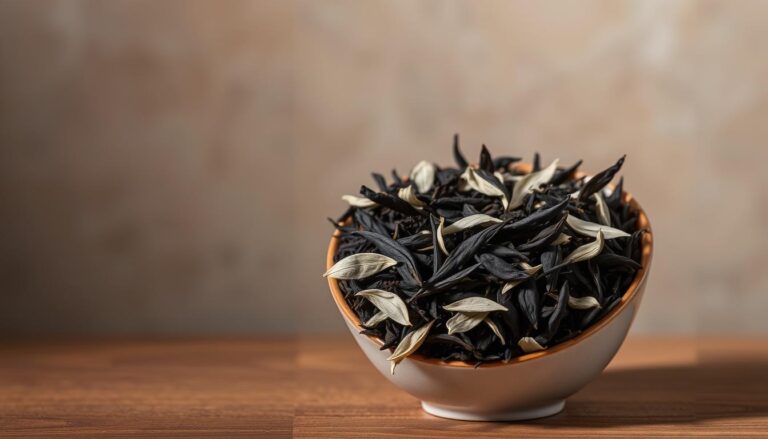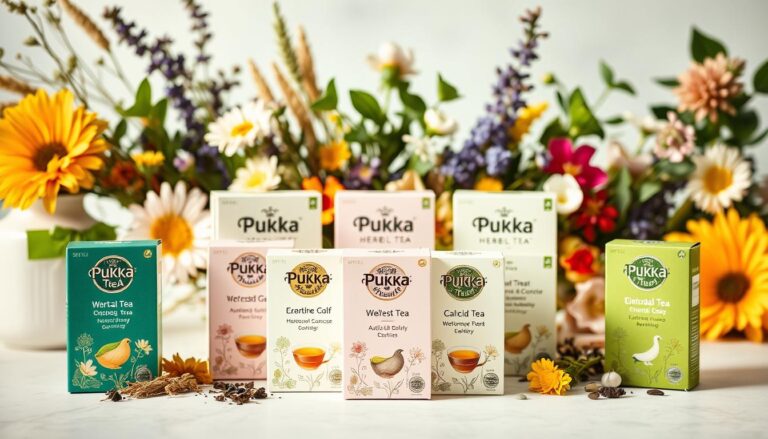Mint Tea: Benefits and Soothing Traditions You’ll Love
Every sip of mint tea whispers ancient healing and comfort. My grandmother would make this magical drink when we felt stressed or had stomach troubles. She taught me how a simple cup could turn bad moments into pure relaxation.
Mint tea is more than a drink; it’s a tradition that connects cultures around the world. It’s been a trusted friend for generations, offering natural wellness and refreshment. From Moroccan desert gatherings to European herbal medicine, mint leaves tea has a long history.
This aromatic drink does more than taste good. Its history and health benefits make mint tea a powerful ally for wellness. It can soothe digestive issues, reduce stress, or just offer a delicious warm drink. Mint tea offers a holistic approach to caring for yourself.
Explore the amazing world of mint tea – a journey of flavor, healing, and tradition. It has been loved across continents for thousands of years. Your wellness adventure begins with this remarkable brew.
Table of Contents
Understanding the Ancient Origins of Mint Tea
Mint-tea has a long history, dating back thousands of years. It has traveled through many cultures. Today, it’s a favorite drink around the world.
The history of mint-tea starts in places where wild mint grew. People used it for its health benefits. They added it to their daily lives and healing practices.
Traditional Uses Throughout History
Ancient people found many uses for mint-tea. Some of these uses might surprise you:
- Digestive support in Egyptian medicine
- Spiritual cleansing in Middle Eastern cultures
- Help for breathing problems
- A cool drink in hot places
Cultural Significance Across Civilizations
Every culture has its own story with mint-tea. Here’s how they made it their own:
| Culture | Mint Tea Significance |
|---|---|
| Moroccan | Symbol of hospitality and friendship |
| Greek | Medicinal herb in Hippocratic treatments |
| Native American | Spiritual healing and purification |
Evolution into Modern Day Beverage
Today’s mint-tea comes from a long history of cultural exchange. Peppermint went from a medicine to a popular drink. It shows how ancient wisdom meets modern health trends.
Learning to make mint-tea connects you to its rich history. It lets you enjoy a drink that has brought joy to people for centuries.
The Health-Boosting Properties of Mint Tea
Mint-tea is a powerful wellness drink that can change your daily routine. It’s loved by many for its health benefits. Unlike other drinks, mint-tea is caffeine-free and supports your well-being.
Does mint tea have caffeine? No, it doesn’t. This makes it perfect for those who want to cut down on caffeine. You can drink it all day without worrying about sleep or jitters.
- Supports digestive health
- Reduces stress and anxiety
- Boosts immune system function
- Provides natural respiratory support
Regular mint-tea can greatly benefit your body. The natural compounds in mint-tea work together to promote balance. It can soothe your stomach and help you relax.
A cup of mint-tea isn’t just a drink—it’s a holistic approach to wellness.
Nutritionists say to drink mint-tea every day for the best results. You can enjoy it hot or cold. Drinking two cups a day can unlock its amazing health benefits.
Essential Nutrients and Compounds in Mint Tea
Mint-tea is more than just a refreshing drink. It’s a treasure trove of nutrients that boost your health. Every sip of mint leaves tea brings you closer to wellness.
Mint-tea is a favorite among health enthusiasts. It’s free from caffeine and has almost no calories. This makes it a great choice for those watching their diet.
Active Components and Their Effects
Mint-tea is packed with active compounds that are good for you:
- Menthol: Provides a cooling sensation and helps relax muscles
- Rosmarinic acid: Supports anti-inflammatory responses
- Flavonoids: Offer powerful antioxidant protection
Antioxidant Properties and Benefits
The antioxidants in mint-tea fight off harmful free radicals. They help keep your cells healthy. This can lower the risk of serious diseases.
Natural Compounds That Support Wellness
Mint-tea is full of natural goodness. It has essential minerals and vitamins that your body needs every day.
Adding mint-tea to your routine is a smart choice. It’s tasty and packed with health benefits, all with almost no calories.
How to Make the Perfect Cup of Mint Tea
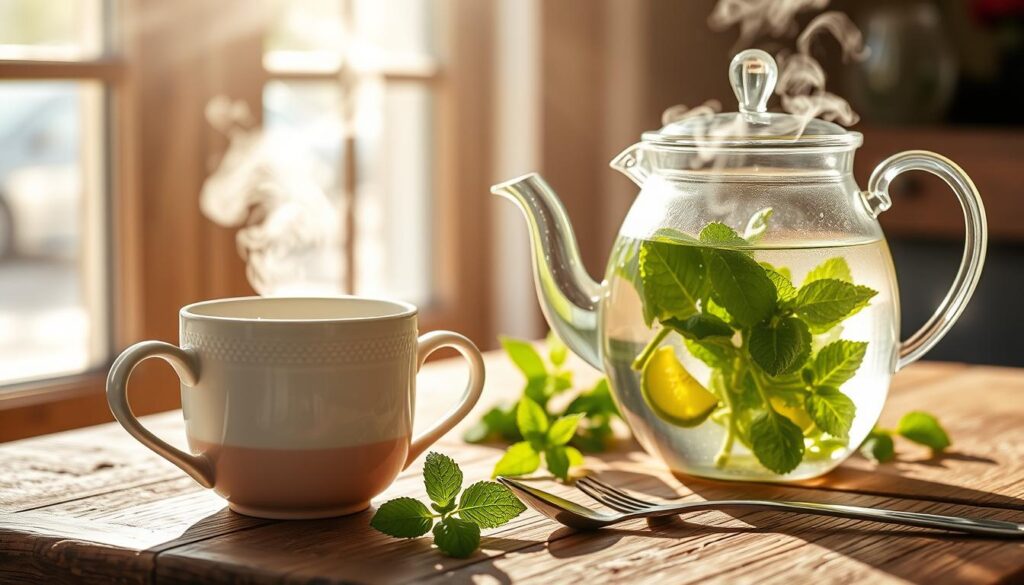

Making mint tea is simpler than you might think. It’s great for both tea newbies and experts. The secret is knowing how to bring out the best flavors.
First, pick your mint leaves wisely. You can use fresh leaves from your garden or high-quality dried ones. Fresh leaves give a stronger taste, while dried ones are easier to use and taste consistent.
- Fresh mint leaves: Pick young, bright green leaves
- Dried mint leaves: Select organic, whole-leaf options
- Tea bags: Choose brands with 100% mint content
Water temperature is key when brewing mint-tea. Use water that’s just below boiling to avoid bitterness. Here’s a quick guide:
| Mint Tea Type | Water Temperature | Steeping Time |
|---|---|---|
| Fresh Leaves | 195-200°F | 5-7 minutes |
| Dried Leaves | 200°F | 3-5 minutes |
| Tea Bags | 212°F | 3-4 minutes |
Want to make your mint-tea even better? Try adding a bit of local honey or a lemon slice. The sweetness of the honey or lemon pairs well with the mint’s cool taste.
Try different brewing methods to find your favorite. Making mint tea is all about enjoying the process and finding what you like best.
Digestive Benefits and Soothing Effects
Mint-tea is great for your digestive health. It’s full of natural healing properties that make each cup soothing. The herb helps your digestive system feel better.
Drinking mint-tea can ease many digestive problems. Studies show it works well for stomach issues. Making mint tea right unlocks its health benefits.
Relief from Digestive Discomfort
Peppermint has special compounds that relax your intestines and reduce inflammation. The benefits include:
- Reducing stomach pain
- Easing bloating sensations
- Supporting smoother digestion
- Minimizing gas and discomfort
Natural Solutions for Bloating
Mint-tea can fight bloating. Its natural properties calm your digestive tract, offering quick relief. Experts suggest drinking mint-tea 30-60 minutes after meals for best results.
Calming Properties for Stomach Issues
To get the most from mint-tea, steep fresh or dried mint leaves in hot water for 5-7 minutes. This extracts the most digestive-supporting compounds. It makes a tasty drink that’s good for your gut.
Nature’s remedy is often the most effective solution for digestive wellness.
Hot vs. Iced Mint Tea Preparation Methods
Making mint-tea is easy and fun. You can enjoy it hot or cold, depending on your mood. Both ways are delicious and refreshing.
Hot mint-tea is cozy and warm. It’s great for when you need a comforting drink. On the other hand, iced mint-tea is cool and refreshing. It’s perfect for hot days.
Hot Mint Tea Preparation
- Select fresh mint leaves or high-quality dried mint
- Boil water to approximately 200°F
- Steep leaves for 3-5 minutes
- Strain and serve immediately
Iced Mint Tea Method
- Brew hot mint-tea using standard hot preparation technique
- Allow tea to cool to room temperature
- Refrigerate for 2-3 hours
- Serve over ice with optional mint garnish
Pro tip for making mint-tea: Experiment with steeping times to adjust strength. Longer steeping creates more intense flavor, while shorter steeping maintains a lighter taste profile.
The key to perfect mint-tea lies in using fresh, high-quality ingredients and understanding your personal flavor preferences.
Bonus suggestion: Try adding a touch of honey or lemon to enhance your mint-tea experience, whether hot or cold!
Combining Mint Tea with Other Herbs
Exploring mint leaves tea opens up exciting possibilities. It lets you create unique herbal blends. Your journey into making mint-tea can be an artistic adventure of flavor and wellness.
To craft the perfect mint-tea blend, know which herbs complement it. Some herbs make magical combinations that enhance your tea experience.
Complementary Herb Combinations
- Chamomile + Mint: Calming and soothing blend
- Ginger + Mint: Warming and digestive support
- Lavender + Mint: Relaxing aromatic infusion
- Lemon Balm + Mint: Bright and uplifting combination
Flavor Enhancement Techniques
When making mint leaves tea, try these flavor-boosting strategies:
- Add fresh citrus zest
- Incorporate natural sweeteners like honey
- Experiment with spices such as cinnamon
- Use fresh mint leaves for intense flavor
Seasonal Blending Ideas
| Season | Recommended Blend | Benefits |
|---|---|---|
| Summer | Mint + Hibiscus | Cooling and refreshing |
| Winter | Mint + Cinnamon | Warming and comforting |
| Spring | Mint + Lemon Balm | Energizing and light |
| Autumn | Mint + Rosehip | Immune-boosting |
Remember, the key to creating exceptional mint-tea blends is creativity and personal preference. Start experimenting and discover your perfect combination!
Daily Consumption Guidelines and Best Practices
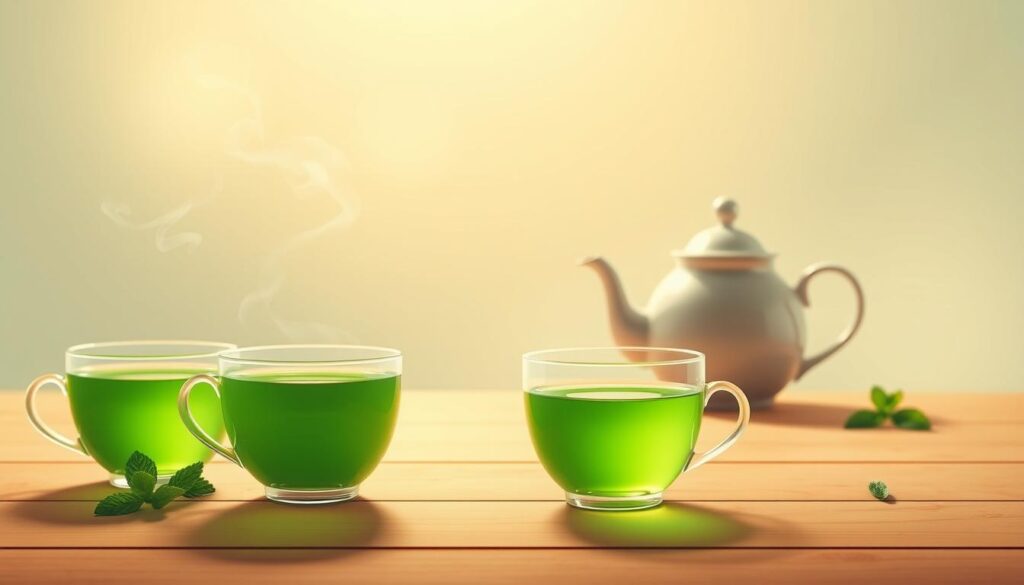

Mint-tea is a delightful drink that’s good for your health. Knowing how much to drink each day can make it even better for you.
Does mint tea have caffeine? The answer is no. Traditional mint-tea doesn’t have caffeine. So, you can drink it anytime without worrying about caffeine’s effects.
- Recommended daily intake: 1-3 cups of mint-tea
- Best times to drink: Morning, afternoon, or evening
- Ideal serving size: 8-12 ounces per cup
How much mint-tea you drink should match your health goals and likes. Listen to your body and notice how it reacts to different amounts. Some people might feel a bit of stomach upset if they drink too much.
Pro tip: Start with one cup daily and gradually increase your intake to understand your body’s unique response.
For health benefits, drinking mint-tea regularly is important. It can help with digestion and feel refreshing. But, pregnant women, people with certain health issues, or those on medication should talk to their doctor first.
Make mint-tea a part of your daily routine. It’s a tasty, hydrating choice that’s good all year round. You can enjoy it hot or cold.
Conclusion
Mint tea is more than just a drink. It combines history and health benefits in a unique way. This refreshing tea has been around for ages and is now love
It is great for your health. It can help with digestion, reduce stress, and is a tasty caffeine-free option. It’s also low in calories and packed with nutrients, making it a smart choice for those who care about their health.
Enjoying min connects you to a long history of wellness. It can add calm and energy to your day. Try different ways of making it and mix it with other herbs to find your favorite.
Start your wellness journey with a cup of mint tea. It offers a refreshing, flavorful, and potentially healthy way to improve your life.

